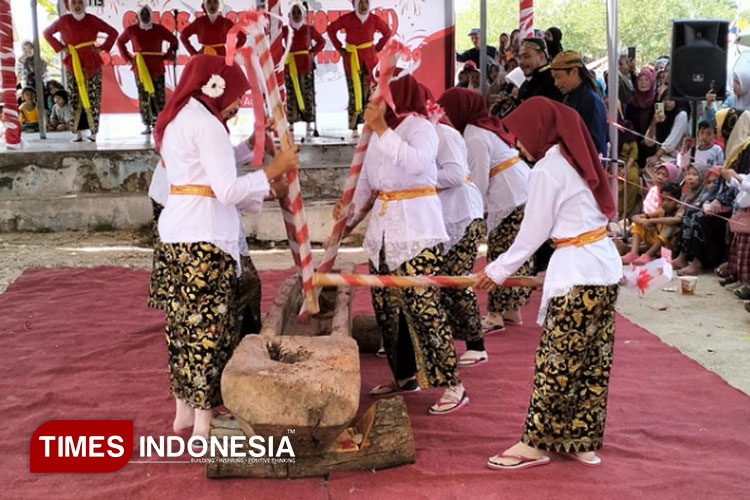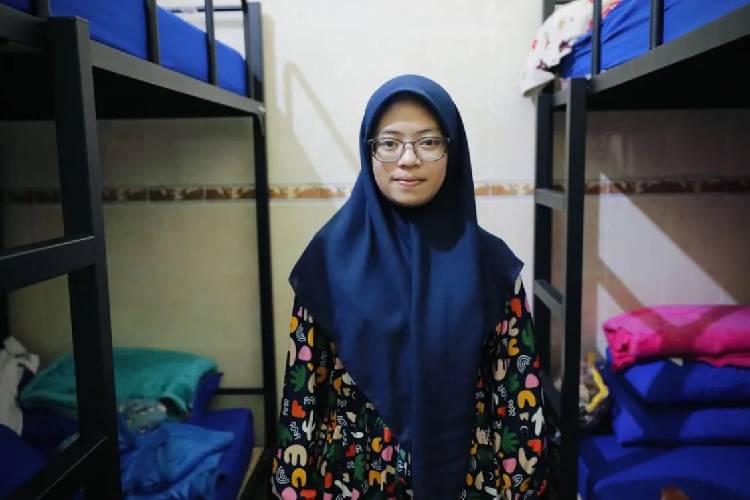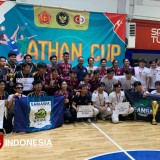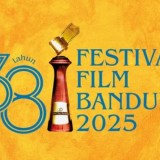TIMES MALAYSIA, GRESIK – On the morning of Saturday, August 23, 2025, the rhythmic pounding of the gejog lesung echoed across the shores of Pasir Putih Dalegan. Nine community teams participated in the Festival Gejog Lesung.
Together they weaving the distinct beats of this traditional percussion instrument with melodic singing, offering both an entertaining spectacle and a meaningful step in preserving ancestral musical heritage.
What is Gejog Lesung?
Gejog lesung is a traditional Javanese musical performance that uses a lesung—a long wooden mortar originally designed for pounding rice—and alu, the heavy pestle-like sticks used to strike it.
When played together, the rhythmic pounding produces percussive sounds that can mimic drum beats. In the past, the instrument was commonly used not only for agricultural work but also as a communal art form during village celebrations, births, and thanksgiving rituals.
Today, gejog lesung is cherished as both a symbol of rural identity and a cultural expression that connects people through rhythm and song.
Historical Roots and Spiritual Meaning
The origins of gejog lesung date back centuries, closely tied to the agricultural life of Javanese villagers. Traditionally, the pounding of rice in a lesung was a daily routine, but over time, villagers began to transform the activity into a musical expression.
The rhythm symbolized harmony between humans and nature, with the sound of the mortar believed to carry prayers of gratitude for abundant harvests.
In some communities, gejog lesung was performed during special ceremonies such as the seventh month of pregnancy (mitoni), welcoming newborns, or harvest festivals.
The performance was seen not only as entertainment but also as a way to strengthen communal bonds, invoking blessings and warding off misfortune. Though modern machinery has replaced manual rice pounding, the tradition survives as a living reminder of ancestral spirituality and togetherness.
Festival Highlights
The atmosphere brimmed with cultural richness as performers adorned themselves in lurik patterns and ancestral Nusantara attire, transporting the audience back in time.
Teams representing various RW (neighborhood associations) and hamlets delivered performances that combined patriotic tunes, the playful nenas song, and wielding two-decade-old lesung with alu.
"It's good to see a ancient tradition brought back to life with this festival. It's kind of exotic," Rahma, a local gen Z who visit the festival said.
Meanwhile, the Head of Dalegan Village, M. Qolib, emphasized the festival’s significance as a part of the village’s commemoration of Indonesia’s 80th Independence Day.
Beyond entertainment, he sees the festival as a vital means to revitalize the almost forgotten art of gejog lesung—historically performed during celebrations such as the birth of a child or someone’s seventh-month pregnancy ceremony.
“Today’s audiences—both villagers and tourists—are highly enthusiastic. They are curious about this nearly extinct tradition,” Qolib noted, hopeful that the festival will cultivate deeper respect for ancestral customs and enhance cultural tourism rooted in community ownership.
As part of the broader Independence Day festivities, Gejog Lesung Festival was one among several planned activities. Gresik was planned to hold several other festival such as an environmental cleanliness competition on August 25, a cultural parade on August 28, culminating in the main reception on August 30, 2025. (*)
Artikel ini sebelumnya sudah tayang di TIMES Indonesia dengan judul: Beats of the Past: Gejog Lesung Resonates Across Dalegan Beach Gresik
| Writer | : Khodijah Siti |
| Editor | : Khodijah Siti |

























